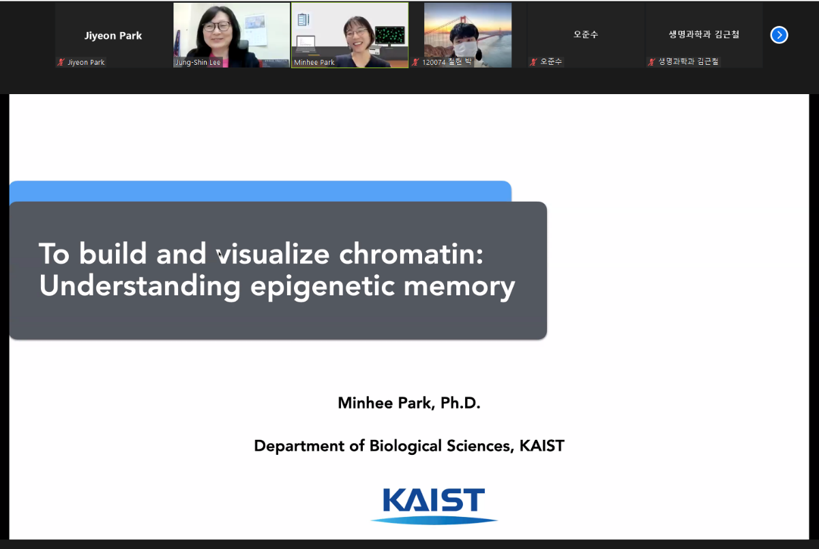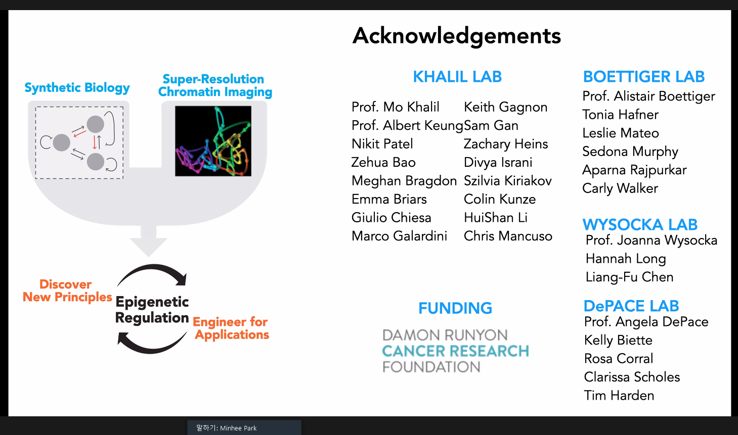제 549회 생명과학연구소 정기세미나_박민희 교수님(KAIST)
페이지 정보
작성자 : 관리자 날짜 : 작성일22-05-31 09:29 조회 : 6,145회본문
일시: 2022년 3월 17일 (목) 오후5시
https://kangwon-ac-kr.zoom.us/j/99696831835?pwd=eHE3a1p4WXkrSUZ3QU1sc0llTEQ1UT09
제549회 생명과학연구소 세미나 2022. 3. 17 (목) 오후 5시, 온라인 https://kangwon-ac-kr.zoom.us/j/99696831835?pwd=eHE3a1p4WXkrSUZ3QU1sc0llTEQ1UT09 |
To build and visualize chromatin: Understanding epigenetic memory
박민희 교수(KAIST 생명과학과)
Epigenetics compose a powerful layer of regulation, credited with the classical example of establishing and perpetuating gene expression patterns that enable cells with identical genomes to exhibit distinct phenotypes. This power inspires repurposing epigenetic elements for development of next generation cellular molecular therapies. However, defining sufficiency for integral properties such as durable inheritance responses has remained elusive. What are the requirements for generating robust yet tunable epigenetic inheritance?
In today’s talk, I apply a bottom-up synthetic biology approach to develop a minimal synthetic epigenetic system based on the principle of classic “read-write” motif to evaluate epigenetic memory. I exploit DNA adenine methylation (6mA), a DNA modification that is rarely found in metazoan genomes, to create a fully synthetic chromatin system in human cells. Together with a quantitative model of chromatin dynamics, I show these circuits mediate spreading of the modification to regulate genes at a distance and the establishment of long-term epigenetic memory, demonstrating the sufficiency of the read-write mechanism for epigenetic memory.
I also explore additional mechanisms (or “motifs”) governing epigenetic regulation, one of which is the 3D chromatin structure. The 3D architecture of the chromatin is thought to be important because it can potentially directly define spatial (rather than genomic) boundaries in which the nucleosomes can talk to each other, and therefore, the modifications can spread. However, a direct function of structural context on epigenetic silencing memory and its cell-to-cell heterogeneity remains unclear due to technical limitations and lack of experimental platforms. I combine user-defined synthetic control of epigenetic silencing and a super-resolution 3D chromatin imaging to systematically and quantitatively delineate 3D chromatin organization and epigenetic memory mechanisms at single-nucleus resolution
학력 및 약력
2008-2012 B.S., Bioengineering, cum laude, Rice University, Houston, TX, USA
2912-2019 M.S./Ph.D., Biomedical Engineering, Boston University, Boston, MA, USA
2020-2021 Damon Runyon Postdoctoral Scholar, School of Medicine, Stanford University, Stanford, CA
2021-present Adjunct Professor, KAIST Institute of the BioCentury
2021-present Assistant Professor, Department of Biological Sciences, KAIST
주요발표논문 (최근)
1. Martinez-Corral R.*, Park M.*, Biette K.*, Friedrich D, Scholes C., Khalil A.S., Gunawardena J., DePace A.H. Transcriptional kinetic synergy: a complex landscape revealed by integrating modelling and synthetic biology. bioRxiv (2020) (*co-first authors)
2. Park M., Patel N., Keung A.J. and Khalil A.S. Engineering epigenetic regulation using synthetic read-write modules. Cell, 176: 227-238 (2019). Recommended by Faculty of 1000
3. Aquino P., … Park M., … Galagan J.E., Coordinated regulation of acid resistance in Escherichia coli. BMC Systems Biology, 11:1-15 (2017)
4. Park M., Keung A.J. and Khalil A.S. The epigenome: the next substrate for engineering. Genome Biology, 17: 183 (2016).









